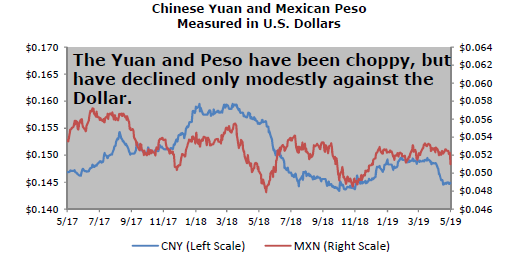
Rising trade tensions with China and a surprise threat to impose tariffs on Mexico (related to the migrant crisis on the southern border) derailed the stock market in May. Indeed, the Dow Jones 30 Industrials ended the month on its longest weekly losing streak in eight years. Investors are fearing the multi-front trade disputes will end the nine-year economic expansion.
Recall the fourth quarter of 2018 witnessed a brief bear market (a decline of more than 20%) that ended the day after Christmas. The S&P 500 and Dow 30 rallied 26% and 23% respectively from that date until the end of April. The S&P reached a new all-time during the rally (as did the NASDAQ), so all-in-all, it was a great reward to those who remained in stocks during the brief bear market.
The shift to higher stakes in the trade battle with China and now Mexico, injected political risk, which along with economic, are the two primary risks facing financial markets. Bullish sentiment quickly reversed into gloom and sent stocks down around 7% for the month of May. Given the scope of the four-month rally, it was not a very large pullback and appears to not have seriously damaged the long uptrend that dates to March of 2009.
The first week of June has seen stocks bounce back strongly; we will reserve judgment about the near-term outlook until the Fed has its regular meeting later in June and the conclusion of the G-20 Summit in Osaka, Japan at the end of the month as well. The US and China are set to meet again at this meeting and hopes are high the trade war will be settled. In the meantime the US and Mexico appear to have reached a migrant deal and the tariff threat is off the table.
Political risk can spill over to the economy. So far, the tariffs on Chinese imports have not caused a serious slowdown in the US economy. However, confidence will likely decline if the trade war escalates, thus risking a much more impactful decline in the economy. We’ll know more later this month.


